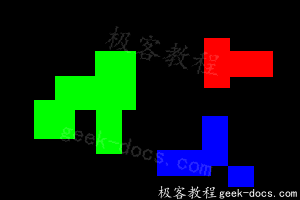在这里我们将Opencv 4-邻域连通域标记变为8-邻域连通域标记。
要进行8-邻域连通域标记,我们需要考察i(x-1,y-1),i(x, y-1),i(x+1,y-1),i(x-1,y)这4个像素。
python实现:
import cv2
import numpy as np
import matplotlib.pyplot as plt
# Read image
img = cv2.imread("seg.png").astype(np.float32)
H, W, C = img.shape
label = np.zeros((H, W), dtype=np.int)
label[img[..., 0]>0] = 1
LUT = [0 for _ in range(H*W)]
n = 1
for y in range(H):
for x in range(W):
if label[y, x] == 0:
continue
c2 = label[max(y-1,0), min(x+1, W-1)]
c3 = label[max(y-1,0), x]
c4 = label[max(y-1,0), max(x-1,0)]
c5 = label[y, max(x-1,0)]
if c3 < 2 and c5 < 2 and c2 < 2 and c4 < 2:
n += 1
label[y, x] = n
else:
_vs = [c3, c5, c2, c4]
vs = [a for a in _vs if a > 1]
v = min(vs)
label[y, x] = v
minv = v
for _v in vs:
if LUT[_v] != 0:
minv = min(minv, LUT[_v])
for _v in vs:
LUT[_v] = minv
count = 1
for l in range(2, n+1):
flag = True
for i in range(n+1):
if LUT[i] == l:
if flag:
count += 1
flag = False
LUT[i] = count
COLORS = [[0, 0, 255], [0, 255, 0], [255, 0, 0], [255, 255, 0]]
out = np.zeros((H, W, C), dtype=np.uint8)
for i, lut in enumerate(LUT[2:]):
out[label == (i+2)] = COLORS[lut-2]
# Save result
cv2.imwrite("out.png", out)
cv2.imshow("result", out)
cv2.waitKey(0)
cv2.destroyAllWindows()
输入(seg.png):

输出:

 极客教程
极客教程